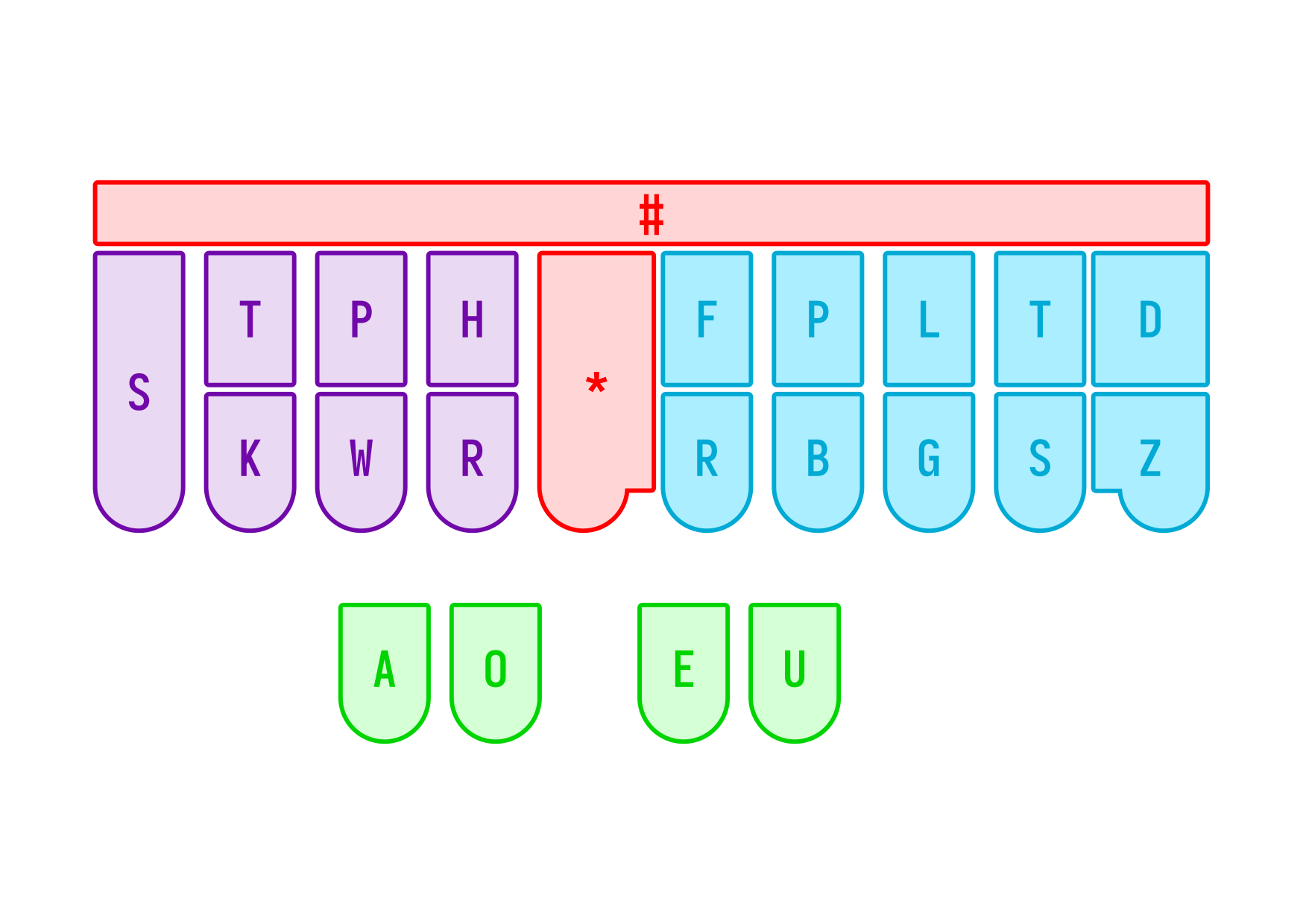Ward Stone Ireland layout: Difference between revisions
(→Key and chord placement: the WSI layout was designed for English) |
(also--probably try to move images to wiki not external) |
||
| (One intermediate revision by one other user not shown) | |||
| Line 1: | Line 1: | ||
{{incomplete}} | |||
The Ward Stone Ireland (WSI) layout is the standard steno layout for all mainstream English steno theories. Its [[steno order]] is: | The Ward Stone Ireland (WSI) layout is the standard steno layout for all mainstream English steno theories. Its [[steno order]] is: | ||
| Line 10: | Line 12: | ||
== Key and chord placement == | == Key and chord placement == | ||
The WSI layout is designed such that its steno order allows for chords that follow English phonotactics (allowable sound sequences within English syllables). On their own, each key represents the sound it is labeled with. To write the word "hot", one would press <code>HOT</code>. Keys can be combined into chords to make up for the missing sounds not on the layout (e.g. "shot" is written as <code>SHOT</code>). The WSI layout allows for many of these simple combinations that match their spellings. | The WSI layout is designed such that its steno order allows for chords that follow [[wikipedia:English_phonology#Phonotactics|English phonotactics]] (allowable sound sequences within English syllables). On their own, each key represents the sound it is labeled with. To write the word "hot", one would press <code>HOT</code>. Keys can be combined into chords to make up for the missing sounds not on the layout (e.g. "shot" is written as <code>SHOT</code>). The WSI layout allows for many of these simple combinations that match their spellings. | ||
However, many sounds in English cannot be composed this way. Some sounds have be assigned key combinations that do not show up in English, such that there will be no ambiguity in the chord. For example, the "b" sound as in "bot" is given <code>PW</code>. Since "pw" is not a valid sound in English, it is safe to use this chord. All of these are also designed and placed such that they can be combined with other chords (e.g. combining <code>PW</code> for "b" and <code>HR</code> for "l" results in the "bl" consonant as in "blot"). | However, many sounds in English cannot be composed this way. Some sounds have be assigned key combinations that do not show up in English, such that there will be no ambiguity in the chord. For example, the "b" sound as in "bot" is given <code>PW</code>. Since "pw" is not a valid sound in English, it is safe to use this chord. All of these are also designed and placed such that they can be combined with other chords (e.g. combining <code>PW</code> for "b" and <code>HR</code> for "l" results in the "bl" consonant as in "blot"). | ||
Latest revision as of 16:34, 23 May 2025
This page is incomplete. If you know about this subject, please contribute to the wiki by adding more information.
The Ward Stone Ireland (WSI) layout is the standard steno layout for all mainstream English steno theories. Its steno order is:
STKPWHRAO*EUFRPBLGTSDZ

History
Chords
Key and chord placement
The WSI layout is designed such that its steno order allows for chords that follow English phonotactics (allowable sound sequences within English syllables). On their own, each key represents the sound it is labeled with. To write the word "hot", one would press HOT. Keys can be combined into chords to make up for the missing sounds not on the layout (e.g. "shot" is written as SHOT). The WSI layout allows for many of these simple combinations that match their spellings.
However, many sounds in English cannot be composed this way. Some sounds have be assigned key combinations that do not show up in English, such that there will be no ambiguity in the chord. For example, the "b" sound as in "bot" is given PW. Since "pw" is not a valid sound in English, it is safe to use this chord. All of these are also designed and placed such that they can be combined with other chords (e.g. combining PW for "b" and HR for "l" results in the "bl" consonant as in "blot").
